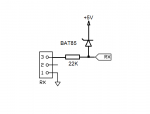Andres Rodriguez
New Member
On a lighting system for a radio controlled airplane, the Picaxes will be reading pulses from the RC receiver. The receiver will be powered with a LiFe battery (peak charge is 6.7V). The Picaxes power is 5V (with LM7805 regulator). My concern is whether the RX pulses (potentially 6.7V) will damage the microprocessors.
The attached PDF file has the schematic.
Andrés
The attached PDF file has the schematic.
Andrés
Attachments
-
23.8 KB Views: 35

